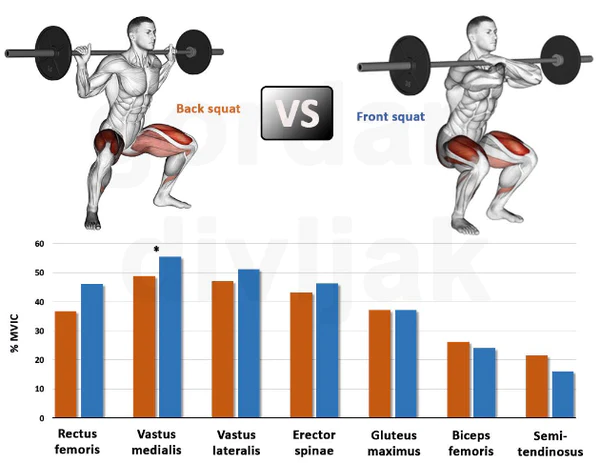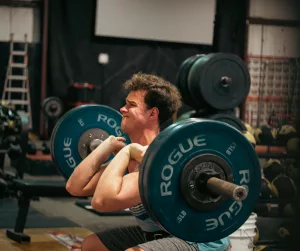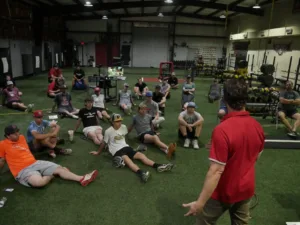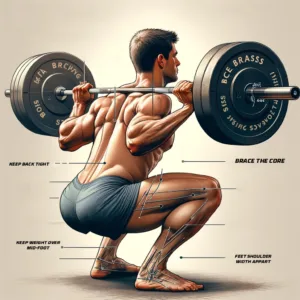 In the world of baseball, optimizing training regimens like Back Squat vs Front Squat is paramount for pitchers seeking to enhance performance and mitigate injury risks. A crucial aspect of this optimization lies in determining the most effective resistance training exercises. Among these, the back squat and front squat stand out, each offering unique benefits. This article delves into the comparison between back squats and front squats, shedding light on their impact on muscle activation levels, particularly relevant for baseball pitchers.
In the world of baseball, optimizing training regimens like Back Squat vs Front Squat is paramount for pitchers seeking to enhance performance and mitigate injury risks. A crucial aspect of this optimization lies in determining the most effective resistance training exercises. Among these, the back squat and front squat stand out, each offering unique benefits. This article delves into the comparison between back squats and front squats, shedding light on their impact on muscle activation levels, particularly relevant for baseball pitchers.
Resistance training forms the cornerstone of athletic conditioning, aiding in strength development, injury prevention, and overall performance enhancement. For baseball pitchers, whose success hinges on arm strength, stability, and endurance, selecting the right exercises is critical. The back squat and front squat emerge as key contenders in this regard, each influencing muscle activation patterns differently.
Key Outcomes of the Study: Back Squat vs Front Squat

Bautista, D., Durke, D., Cotter, J. A., Escobar, K. A., & Schick, E. E. (2020). A comparison of muscle activation among the front squat, overhead squat, back extension and plank. International Journal of Exercise Science, 13(1), 714.
The study titled "A Comparison of Muscle Activation Among the Front Squat, Overhead Squat, Back Extension, and Plank" provides valuable insights into the efficacy of various resistance exercises. It highlights the following key outcomes relevant to back squats and front squats for baseball pitchers:
Anterior Deltoid (AD) Activation
- Back Squat vs Front Squat For Baseball Pitchers: The study indicates that front squats result in significantly higher AD activation compared to back squats, particularly at higher intensity levels. This suggests that front squats may offer better engagement of the shoulder muscles crucial for stabilizing the barbell during pitching motions.
Middle Trapezius (MT) Activation
- Back Squat vs Front Squat For Baseball Pitchers: Conversely, middle trapezius activation is greater during back squats, especially at higher intensities. This highlights the potential of back squats in engaging the upper back muscles necessary for maintaining proper posture and stability during pitching movements.
Erector Spinae (ES) Activation
- Back Squat vs Front Squat For Baseball Pitchers: Both back squats and front squats elicit higher ES activation compared to other exercises analyzed in the study. This underscores the effectiveness of both variations in strengthening the lower back, crucial for overall spinal health and pitching performance.
Core Muscle Activation (Rectus Abdominis and External Oblique)
- Back Squat vs Front Squat For Baseball Pitchers: While both squat variations activate core muscles to some extent, the plank exercise shows significantly higher activation of the rectus abdominis and external oblique. This emphasizes the importance of incorporating plank exercises in training regimens to target core strength and stability, essential for pitching performance and injury prevention.
 Back Squat vs Front Squat For Baseball Pitchers: A Closer Look
Back Squat vs Front Squat For Baseball Pitchers: A Closer Look
- Impact on Shoulder Stability: Shoulder stability is paramount for baseball pitchers, as it directly influences throwing mechanics and injury risk. The front squat, with its emphasis on anterior deltoid activation, offers benefits in strengthening the shoulder complex, potentially enhancing stability during pitching motions.
- Upper Back Engagement: Proper posture and scapular stability are vital for pitchers to generate power and maintain accuracy. Back squats, by eliciting greater middle trapezius activation, contribute to upper back strength, aiding in posture maintenance and reducing the risk of shoulder injuries.
- Lower Back Strength and Spinal Health: The lower back plays a crucial role in pitching mechanics, providing support and power generation. Both back squats and front squats target the erector spinae, promoting lower back strength and overall spinal health, essential for enduring long pitching seasons.
- Core Stability and Injury Prevention: Core stability is foundational for efficient transfer of power from the lower body to the upper body during pitching. While squats engage core muscles to some extent, incorporating plank exercises into training routines can further enhance core strength and stability, reducing the risk of injuries and improving pitching performance.
Olympic-Based Training with TopVelocity Programs
 At TopVelocity, our training philosophy is rooted in Olympic-based principles, harnessing the power of proven techniques to enhance athletic performance. Both the front squat and back squat are integral components of our comprehensive programs, designed to optimize the potential of baseball pitchers.
At TopVelocity, our training philosophy is rooted in Olympic-based principles, harnessing the power of proven techniques to enhance athletic performance. Both the front squat and back squat are integral components of our comprehensive programs, designed to optimize the potential of baseball pitchers.
Front Squat: Back Squat vs Front Squat
Incorporating the front squat into our training regimen allows pitchers to target specific muscle groups essential for their success on the mound. By placing the barbell across the front of the shoulders, this exercise emphasizes quadriceps, core, and shoulder stability. This translates to improved lower body strength and explosiveness, crucial for generating pitching velocity and maintaining proper mechanics throughout the game.
Back Squat: Back Squat vs Front Squat
Similarly, the back squat plays a vital role in developing lower body strength and power. By placing the barbell across the upper back, this exercise engages the glutes, hamstrings, and lower back muscles, providing pitchers with the foundation they need to drive off the mound with force and precision. The back squat is instrumental in building overall lower body strength, essential for maintaining pitching velocity and endurance over the course of a game or season.
More about TopVelocity Programs:
 Our programs go beyond traditional strength training, incorporating cutting-edge techniques and personalized coaching to unlock each athlete's full potential. Whether you're looking to increase pitching velocity, improve control, or prevent injury, TopVelocity offers a range of scientifically backed programs tailored to your specific needs and goals.
Our programs go beyond traditional strength training, incorporating cutting-edge techniques and personalized coaching to unlock each athlete's full potential. Whether you're looking to increase pitching velocity, improve control, or prevent injury, TopVelocity offers a range of scientifically backed programs tailored to your specific needs and goals.
Ready to take your pitching to the next level? Join the TopVelocity community today and experience the difference Olympic-based training can make in your performance. Visit our website to learn more about our programs and start your journey toward becoming a dominant force on the mound.
Take the first step toward greatness with TopVelocity - Your path to pitching excellence starts here.
FAQs: Back Squat vs Front Squat
Q: Which squat variation is better for baseball pitchers, back squat, or front squat?
A: The choice between back squats and front squats depends on individual preferences and training goals. Both variations offer unique benefits, with back squats emphasizing upper back strength and front squats targeting shoulder stability.
Q: How often should baseball pitchers incorporate squats into their training regimen?
A: Squats can be integrated into pitching-specific strength training routines 2-3 times per week, focusing on proper form and gradually increasing resistance to promote muscle adaptation and performance gains.
Q: Are squats alone sufficient for developing core strength in baseball pitchers?
A: While squats engage core muscles to some extent, additional exercises targeting core stability, such as planks and rotational movements, are recommended to comprehensively develop core strength and minimize injury risks.
Q: Can front squats help improve pitching velocity?
A: Front squats can contribute to improved pitching performance by enhancing shoulder stability and upper body strength, factors crucial for generating pitching velocity and maintaining accuracy.
Q: How should baseball pitchers incorporate plank exercises into their training routine?
A: Plank exercises should be included in pitching-specific workouts as supplementary exercises focusing on core strength and stability. Aim for 2-3 sets of 30-60 seconds, gradually increasing duration and intensity as strength improves.
Q: What role does lower back strength play in pitching performance?
A: Lower back strength is essential for providing stability and power during pitching motions. Strengthening the erector spinae through exercises like squats contributes to overall spinal health and pitching durability.
In conclusion, the comparison between back squats and front squats for baseball pitchers reveals nuanced differences in muscle activation patterns and potential benefits. By understanding these differences, pitchers and coaches can tailor training programs to optimize performance and reduce injury risks, ultimately enhancing their effectiveness on the mound.
For more exclusive content visit TopVelocity Patreon!


 Back Squat vs Front Squat For Baseball Pitchers: A Closer Look
Back Squat vs Front Squat For Baseball Pitchers: A Closer Look